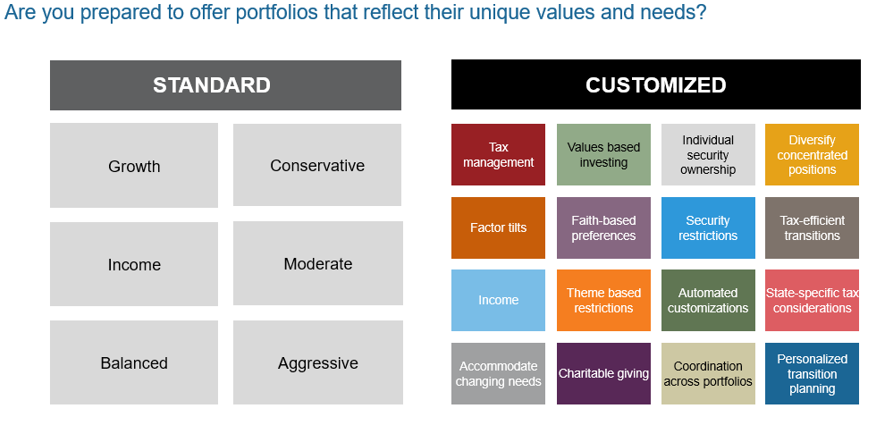Executive summary:
- An advisor’s role is to ensure that each investor’s portfolio reflects their individual needs and circumstances.
- Direct Indexing allows advisors to do just that, creating the potential for significant value-add
- Offering Direct Indexing options may help advisors build their business as they can help solve each client’s specific issue
As an advisor, you know that no two clients are alike. Each has their own financial goals, risk tolerance and opinion on how they want to invest. Each comes to you with a different starting point: with or without an existing portfolio, and at a unique age, marital status, financial situation, and outlook, among other characteristics. Your role is to ensure their portfolio reflects their individual preferences and meets their future needs.
One strategy that could help you do just that is Direct Indexing. You may have been hearing a lot about it recently. That’s because its ability to help you create a personalized portfolio for each client is spurring its tremendous growth.
After all, we know that the trend in personalization is expanding across all aspects of our lives – at the coffee shop, on our streaming apps, and even in our transportation (way beyond business class and coach!). Personalization has also become a key aspect of financial planning. And why not? Just as every family is different, every investment plan is different. Every person has different goals, circumstances and preferences – all of which can evolve across their lifecycle.
Your clients expect personalization

Hypothetical scenario for illustrative purposes only.
Over the last few years, I and my colleagues at Russell Investments have written numerous blogs on direct indexing and the impact it is having on the investment industry. Among the many topics discussed: Top Five Reasons to use Direct Indexing, the tax advantages of using direct indexing and using direct indexing for charitable gifting.
In this blog I will discuss how a financial advisor can implement a direct indexing strategy to grow their business by focusing on the specific groups that could benefit from the customization capabilities that direct indexing offers.
What is Direct Indexing?
In its simplest form, direct indexing is a strategy in which an investor hires a portfolio manager to purchase a selection of the securities that make up a specific index and hold them in a Separately Managed Account (SMA). This gives the investor similar market exposure as the index but also gives them the opportunity to build a customized portfolio. The investor can exclude certain securities to reflect their specific goals, needs, or circumstances. This approach not only allows for greater customization but also greater flexibility.
How can a financial advisor use direct indexing to attract new clients?
As a financial advisor, it may be a good growth strategy to target specific groups who can benefit from using a direct indexing approach.
By offering a direct indexing option, you can tailor each client’s portfolio to their specific needs. You can recommend a proper benchmark and then give your client the option to tweak their portfolio to their unique situation. This capability could be very attractive to investors who have strong opinions on how they want to invest, as well as to investors with concentrated portfolios or embedded capital gains.
We have found that much of the value an advisor provides comes from their ability to create personalized investment plans for their clients. Imagine how much more value you could provide if you could build a portfolio that clearly aligns with each of your clients’ goals, needs and circumstances – and helps solve their specific issues.
Examples could be:
Individuals who are overweight their company stock.
- Direct indexing can restrict their company stock as well as similar companies or sectors in their portfolio thus potentially reducing overall risk.
Small institutions who want their investment portfolios to represent their values. e.g., Religious groups, environmental or socially conscious organizations, schools, etc.
- A theme-based restriction can give the investor group exposure to an index but eliminate the companies that do not align with their mission statement. A school, for example, may want passive exposure to the S&P 500 but restrict alcohol and cannabis stocks.
Employees at companies that restrict purchasing stock in their clients’ companies. e.g., Accounting and consulting firms.
- Direct indexing can restrict the purchase of any stock that the client is not eligible to purchase.
Individuals who want to implement their religious values in their portfolio.
- Direct indexing allows the investor to choose a benchmark and restrict any individual companies, or in some cases, choose a specific theme that implements the restrictions determined by a certain religion.
Your direct indexing provider may offer preset screens or themes that you can select for your clients. The table below shows some of the potential options:
Direct indexing is experiencing tremendous growth. Why not use it to grow your practice?
Assets in direct indexing portfolios reached $535.1 billion in assets under management at the end of Q3 20231. A report by Cerulli Associates projects that direct indexing will make up 33% of the retail SMA market by 2026 and assets held in direct indexing products will reach $800 billion2.
As a financial advisor looking to grow your business, it may be smart to consider using direct indexing not only with your existing clients but as a way to attract new ones as well.
1 Source: FUSE, Money Management Institute, Cerulli Associates.


